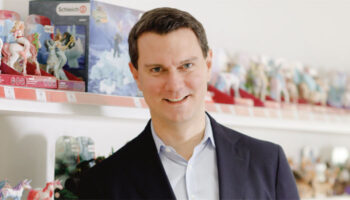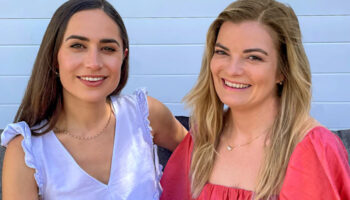Whitney and Alex Kimerling discuss what makes a product right for Hootenanny Games

How terrific to see you both! Thanks for making time. For those that haven’t had the pleasure, who are you?!
Alex: I’m Alex, President of Hootenanny Games…
Whitney: And I’m Whitney, the Chief Creative Officer of Hootenanny Games.
I’ve got the President and The Chief Creative Officer, what a coup! Now tell me: What kind of products does Hootenanny put out? What do you look for?
Whitney: We really want games that can do double duty in your game cabinet! Games that are really fun if you want to sit down and play them with your kids. But if your kids get up and walk away from the table, games that you still want to play with your friends! We want that unicorn where everybody finds fun.
Beautiful! Great answer. And in that respect then, Whitney, are you – when inventors tap, tap, tap at the door – thinking: ‘I’ll know it when I see it!’ Or do you feel you can brief to find the right games?
Whitney: A little of both. We’re able to be flexible and nimble… That means if something comes up that’s not in a specific box we’re looking for – but we love it – we can still incorporate it. Even if an idea doesn’t necessarily fill a specific bucket at the right time, we’ll still say, “That’s really cool!”
But from that, one infers there ARE specific buckets…
Whitney: Right! Because we’re building our line with a solid foundation. We started with our first four games: a dice game, a card game, a party game and a light-strategy board game. We specifically wanted to come out of the gate with those because we felt they gave us a firm foundation on which to build. There’s a little something for everybody. And now we’ve added in the Sour Patch Kids game as our fifth title – with three new games coming out next year.

We’re going to discuss the Sour Patch Kids game in an article for Brands Untapped. People can read that here. As regards the other games, how do they break down, Whitney?
Whitney: There’s another light strategy and two family or party games. And our plan for growth is three to four new titles each year. But again: if we end up with four, great. If we end up with three, great. We want to make sure that anything we add to the range is very intentional… We don’t want to be thinking: ‘We need to snatch up another one just so that we hit a certain number of releases…’ Everything’s still going to be fully vetted so that it fits under the Hootenanny umbrella.
Great stuff! You’re answering a lot of my questions as you go, Whitney; loving it! Now, you use the word vetted… Let’s go through your process! I’ve come to you, and I want to pitch you a game. First of all, how do you like to be pitched to? What is it you like to see?
Whitney: If we’re in person, we absolutely want to talk through the gameplay and play the game with you. I want to utilise our time together for us to play… Because it’s the best way to understand your game and get a good feel for it.
So just to clarify, it would be a mistake for me to turn up in person and say, “Well, let me show you the sizzle!” and hit play?
Alex: A sizzle is an okay starting point. But if a 30-second sizzle has got my interest, great… Let’s play it! We want to be able to sit down, pull it out and play. We can’t always be face to face, of course, but that’s the best way to play– because there’s no better person to play the game with than the inventor.
Whitney: Of course, with so many of our pitches being over Zoom, it’s much harder do that. But it’s important that we really playtest games. Very rarely would we think about licensing anything on the spot because we want it to be a unanimous decision. Alex and I both have to really love a game – but we have very different likes and dislikes; we represent very different parts of the game market. So if it’s something we both agree on, there’s a good chance it’ll have that sort-of ‘unicorn status’… Something that spans a lot of different interests.

Alex: Yes… So it’s just about real playtesting. If we show it to a few groups and the answer is anything other than a wholehearted, “Yes! I want to play again!” then it’s a no from us. We’re looking to set a pretty high bar and have a large percentage of people say, “This is the best game I’ve ever played!” Because otherwise how do you find the great options?
Whitney: And I’ll just tell you this, Deej: last year, we had a game that Alex and I both thought was great. It was almost the exception to the rule – we almost licensed it on the spot… But then we said we were going to stick to our playtesting rules. And when we playtested it, it was not well received! It was so shocking to us because we loved it. And that just solidified our process.
Fascinating! And in terms of people showing you their prototypes, how finished do they need to be?
Whitney: Oh, we’ve seen everything from popsicle sticks and air-dried clay to blank cards and laminated paper as a whiteboard… That’s just fine – it doesn’t matter as long as it’s playable… If we can sit down and play it, I can have the vision for what the ultimate end game looks like. I don’t have to have art files and all of that. In fact, in a lot of ways, I like it better if it’s not already themed! Because it doesn’t interfere with our brainstorming process…
Oh! I find that interesting because some inventors screw the theme down so tightly: “It has to be ponies and gnomes!” Whereas it sounds like it’s better if you, Whitney, can say, “Well not ponies and gnomes: it needs to be unicorns and dwarves!” or whatever…
Whitney: Right. And I don’t want a theme to hinder it if, say, we have a ponies and cows game that’s already coming out… And now I really like your ponies and gnomes game – but I can’t have two games with ponies! Because if you’re absolutely wedded to that theme, that might be a hindrance for all of us.
Alex: We also have an incredible graphic development team for these games… When we’re brainstorming the best themes or the best art direction, there are several of us around the table, which helps us really think outside the box and get differing real-time opinions.
Brilliant. Well, I think that gives us a pretty good insight into how you like to see games pitched, and what happens after. So thank you! Let’s wrap it up there and I’ll go and prepare my new game ready to pitch: Gnomes versus Dwarves…
Whitney: Oh! What happened to the ponies?
Oh, I’ve gone off the ponies! Ponies are over… They’re gone. I’m like that; I’m an artist!
–
To stay in the loop with the latest news, interviews and features from the world of toy and game design, sign up to our weekly newsletter here

























